Difference between revisions of "Mangroves"
(→Introduction) |
(Undo revision 25657 by Jackgeerlings (Talk)) |
||
| Line 4: | Line 4: | ||
Mangrove forests or '''mangals''' are a type of [[intertidal]] wetland [[ecosystems]]. The word mangrove is derived from the Portugese word mangue which means “tree” and the English word grove which is used for trees and shrubs that are found in shallow, sandy or [[mud]]dy areas. <ref>Karleskint G. 1998. Introduction to marine [[biology]]. Harcourt Brace College Publishers. p.378</ref> They replace [[Salt marsh]]es in tropical and subtropical regions. | Mangrove forests or '''mangals''' are a type of [[intertidal]] wetland [[ecosystems]]. The word mangrove is derived from the Portugese word mangue which means “tree” and the English word grove which is used for trees and shrubs that are found in shallow, sandy or [[mud]]dy areas. <ref>Karleskint G. 1998. Introduction to marine [[biology]]. Harcourt Brace College Publishers. p.378</ref> They replace [[Salt marsh]]es in tropical and subtropical regions. | ||
| − | They are salt-tolerant forested [[wetlands]] at the sea-land interface which forms the link between the terrestrial landscapes and the marine environment. The dominant plants are several species of mangrove (for a species overview, check the Mangrove Species Database <ref name="vliz"/>). | + | They are salt-tolerant forested [[wetlands]] at the sea-land interface which forms the link between the terrestrial landscapes and the marine environment. The dominant plants are several species of mangrove (for a species overview, check the Mangrove Species Database <ref name="vliz)"/>). |
Mangroves are woody trees and shrubs with a thick, partially exposed network of roots that grow down from the branches into the water and sediment. They occur where there is little [[waves|wave action]] and where [[sediments]] accumulate. These fine grained (muddy and sandy) sediments lack oxygen. <ref>Hogarth P.J. 1999. The biology of mangroves. Oxford University Press. p.228</ref> | Mangroves are woody trees and shrubs with a thick, partially exposed network of roots that grow down from the branches into the water and sediment. They occur where there is little [[waves|wave action]] and where [[sediments]] accumulate. These fine grained (muddy and sandy) sediments lack oxygen. <ref>Hogarth P.J. 1999. The biology of mangroves. Oxford University Press. p.228</ref> | ||
They are frequently associated with saline [[Lagoon|lagoons]] and are regularly found on protected sides of islands, [[Island atolls|atolls]] and tropical [[estuaries]]. <ref>Karleskint G. 1998. Introduction to marine biology. Harcourt Brace College Publishers. p.378</ref> | They are frequently associated with saline [[Lagoon|lagoons]] and are regularly found on protected sides of islands, [[Island atolls|atolls]] and tropical [[estuaries]]. <ref>Karleskint G. 1998. Introduction to marine biology. Harcourt Brace College Publishers. p.378</ref> | ||
| Line 10: | Line 10: | ||
[[image:mangrove thailand.jpg|center|thumb|450px|caption|Mangal in Thailand <ref>http://teqje.web-log.nl</ref>]] | [[image:mangrove thailand.jpg|center|thumb|450px|caption|Mangal in Thailand <ref>http://teqje.web-log.nl</ref>]] | ||
| + | |||
| + | |||
==Distribution== | ==Distribution== | ||
Revision as of 14:05, 13 December 2008
This article describes the habitat of the Mangrove forests. It is one of the sub-categories within the section dealing with biodiversity of marine habitats and ecosystems. It gives an overview about the characteristics, distribution, biota, functioning and adaptation to general problems the organisms are facing with. A short discussion about the threats is also present.
Contents
Introduction
Mangroves are the only trees that are capable of thriving in salt water. They form unique intertidal forests at the edge of land and sea. They are represented on all continents with tropical and subtropical coasts, i.e. North and South America, Africa and Middle-East, Asia and Oceania (incl. Australia). [1]
Mangrove forests or mangals are a type of intertidal wetland ecosystems. The word mangrove is derived from the Portugese word mangue which means “tree” and the English word grove which is used for trees and shrubs that are found in shallow, sandy or muddy areas. [2] They replace Salt marshes in tropical and subtropical regions. They are salt-tolerant forested wetlands at the sea-land interface which forms the link between the terrestrial landscapes and the marine environment. The dominant plants are several species of mangrove (for a species overview, check the Mangrove Species Database [3]). Mangroves are woody trees and shrubs with a thick, partially exposed network of roots that grow down from the branches into the water and sediment. They occur where there is little wave action and where sediments accumulate. These fine grained (muddy and sandy) sediments lack oxygen. [4] They are frequently associated with saline lagoons and are regularly found on protected sides of islands, atolls and tropical estuaries. [5]
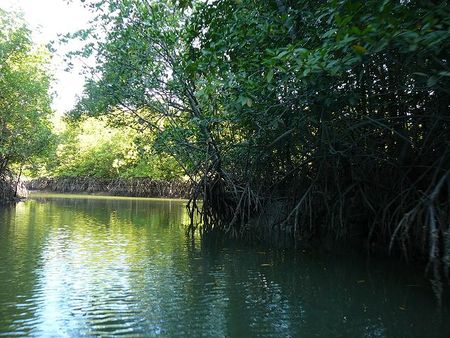
Distribution
The distribution, density and species composition are determined by the water and air temperatures during the winter, exposure to wave action and tidal currents, the range of the tide, the type of sediment and the chemistry of the seawater. The most highly developed and most species rich mangals are found in Malaysia and Indonesia. Over the world, 54-70 species (for a species overview, check the Mangrove Species Database [1](and hybrids) in 20-27 genera and 16-19 families are found. [7]
They are almost exclusively tropical, but are also seen in the subtropics. Mangroves are intolerant of frost, but can tolerate air temperatures as low as 5°C. They are most closely correlated with the seawater temperature. The 20°C isotherm in the winter is a good indicator for the limit of distribution. The number of species tends to decrease with the distance from the equator. In the southern hemisphere, ranges extend further south on the eastern margins of land masses than on the western. This is because of the pattern of warm and cold ocean currents. But local anomalies of current and temperature or the local evolution can create local changes. [8] [9]
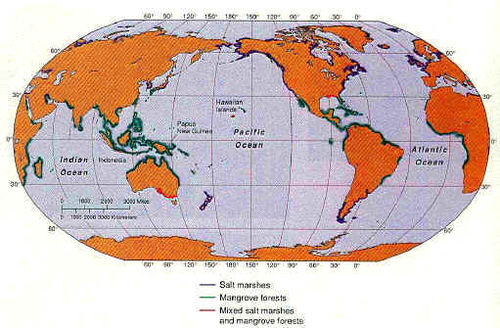
Requirements for development
Mangroves have several requirements to develop.
- They need average temperatures of the coldest month higher than 20°C. The seasonal temperature range should not exceed 5°C. They can tolerate temperatures of 5°C, but the development will be affected. They are not resistant to freezing.
- In general they need a fine-grained substrate. But there could be some exceptions. This is the case in Papua New Guinea and Kenya, where the mangroves grow on corals.
- The shores must be free of strong wave action and tidal current.
- They need salt water. They are facultative halophytes.
- They need a large tidal range. This causes limited erosion and deposition of sediments.
Due to these processes, a well-marked zonation is seen. Each of the zones is dominated by a different mangrove species and associated fauna and flora. Red mangroves (Rhizophora) are usually found the closest to the edge of the water, where the greatest degree of tidal flooding occurs. More landwards are the black mangroves (Avicennia). These areas receive only shallow flooding during high tide. The upper limit of the mangroves is occupied with white mangroves and buttonwoods. The buttonwoods are not really a mangrove species, but are a transition species between the mangrove and the terrestrial vegetation.
Functioning and adaptations
The mangroves have several functions and adaptations to a life in an intertidal ecosystem. They need to conquer some problems to be resistant to the environment. The first problem is that mangrove trees are freshwater riverine trees. They grow in an environment whose salinity ranges between that of freshwater and seawater. For this reason, they have to take up water against the osmotic pressure. To overcome the negative osmotic pressure, they generate a negative hydrostatic pressure (by transpiration processes). They developed a mechanism to exclude salt by the roots or leaves. In this way, they are tolerant for saline conditions. Even with exclusion of most of the salts, concentration of chloride and sodium ions in the tissue is higher than other plants. This high concentration can inhibit many enzymes. To protect the enzymes, the salt is stored in vacuoles. The high cation concentrations are balanced by high non-ionic solutes in the cytoplasm. Several mangrove species deposit sodium and chloride in the bark of stems and roots. Other species deposit salt in senescent leaves, which later fall off the tree. Salt glands on the leaves also exclude salt. This can be seen as salt crystals. The lower surface of the leave is highly covered with hairs to raise the secreted droplets of salty water away from the leaf surface. This prevents osmotic withdrawal of water from the tissue. They also restrict the opening of their stomata (only on the lower surface of the leaf), have a tick cuticle with a waxy layer, and orientate their leaves to avoid the burning sun. This also reduces evaporation. Because salt tolerance is costly, a greater relative root mass is needed to recover the demand for water. When it rains, drop roots, descending from the branches, absorb the freshwater that runs down from the stem through a special superficial layer. In this way, no high-energy inverse osmosis is needed.
A second problem is the anoxic environment. The underground in which they root is saturated with water. The tissue of the plants requires oxygen for respiration. Gas diffusion between gas particles can only supply this need in soils that are not waterlogged. Even when the water is saturated with oxygen, its concentration is too low and the diffusion in water is very slow. This is solved by various forms of aerial roots.
- The most roots branch off from the stem underground. One type of roots is the prop root or rhizophore. This root diverges from the tree and anchors into the bottom to stabilize the tree in the soft, muddy substrate. The rhizophore has lenticels on the upper surface. Lenticels are large pores with a corky layer and enable the exchange of air. Seawater can not get in the lenticels. The tissue of the prop roots consists of aerenchyma and is connected with the lenticels. Through this aerenchyma, air can be provided to the submerged parts of the tree. The root can periodically break the soil surface and submerges again. This forms a knee root.

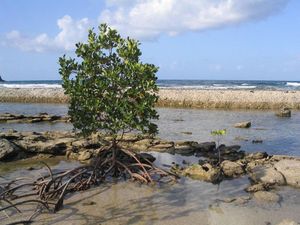
- Another type of roots is a shallow, horizontal root that radiates outwards. The vertical root is called a pneumatophore and can be as high as several decimeters. They also have lenticels and aerenchyma. This can create a huge network of vertical roots. The horizontal root is called the cable root.
- At last, the buttress root is a root that covers the whole space between the upper part of the root and the bottom.
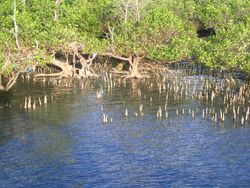
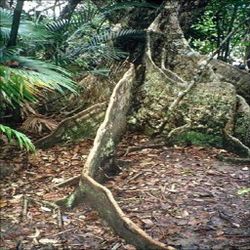
The pollination of the trees is by the wind or by organisms. All mangroves disperse their offspring by water. They produce unusually large propagating structures or propagules. The embryo initiates germination on the seed, still attached on the tree and further develops into a propagule. This phenomenon is known as vivipary.
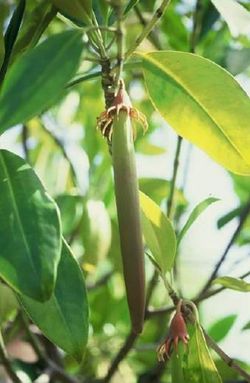
Mangroves aid soil formation by trapping debris. Prop roots and pneumatophores accumulate sediments in protected sites and form mangrove peats. The filamentous algae also help to stabilize the fine sediments trapped by mangroves. They usually form a green-to-red mass over the substrate. They are also a filtering system for the land run-off and remove the terrestrial organic matter. They are very important habitats for many species of small fish, invertebrates and various epiflora and epifauna as well as larger birds. This is called a nursery function. The mangrove is a major producer of detritus that will contribute to offshore productivity in some seasons. [14]
Biota
Micro-algae are important in mangrove ecosystems. They are epiphytic and grow on the aerial roots of the trees and on the sediments. The algae are green ( Chlorophyta), brown (Phaeophyceae), red (Rhodophyta) and blue-green (Cyanophyta). The dens biomass on the aerial roots causes the water to remain on the pneumatophores. The lenticels are no longer functional and oxygen can not penetrate into the roots. For this reason, the bark regularly falls off the root. This process is called decertification. Vertical zonation along a single pneumatophore occurs, but there is also a zonation from the upper limit of the mangroves to the lower limit.
A number of invertebrates are found in the mangrove ecosystem. Macrobenthic species can be commonly found or they could only occasionally been found because they are migrating within it or because they are living in adjacent environments. Crabs are commonly found in the mangroves. They are keystone species. This means that the presence of this animal in the community makes it possible for many other species to live there. The crabs go through their larval stages in the water beneath the mangroves. When they are mature, they crawl up on the mangroves and feed on the leaves. They are crucial in the processing of the leaf litter. They can reach high densities. Burrow activities also take place. The micro-topography of the bottom will be modified and the soil will be aerated. This decreases the sulphide levels in the soil and positively influences the productivity of the trees. An example of a mangrove crab is the fiddler crab Uca lacteal.
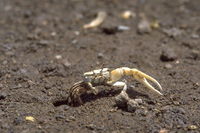
An important bivalve is the purple oyster Lopha frons. This species encrusts the pneumatophores and prop roots. When the tide is high, barnacles and mussels compete with the oyster for space on the roots. Periwinkles also occur on the roots and stems, as well as on the shells of sedentary organisms attached on them. Snails are extremely important in the turn over of the organic material.
Other species that occur in the mangroves are tunicates, sponges, ants, hermit crabs, shrimps, fishes,… They may be a source of nutrition for higher level predators. Species that cannot tolerate the changing saline conditions can survive in the forest. These species are sea stars, brittle stars and sea squirts. Predators are clapper rails, diamondback turtles, water moccasins, raccoons and killifishes. Bacteria and fungi initially break down the leaf litter (decomposition).
In the tree canopy, vertebrate fauna and birds are common. Examples of birds are pelicans, wood ibises, herons, egrets and roseate spoonbills. [16] [17]
Egret Egretta alba <ref>http://en.wikipedia.org/wiki/Snowy_Egret</ref
Water moccasin Agkistrodon contortrix [18]
Diamondback turtle Malaclemys terrapin [19]
Threats
The mangroves are threatened in their existence by several causes. The main source of these threats are induced by humans.
- Variations in river and surface run-off, that inhibit the tropical coastal deltas of fresh water and silt, cause losses of mangrove species diversity and organic production. This results in alternations in both the terrestrial and aquatic food web. This has an effect on the types of refugees available to consumers.
- People will always be engaged in making projects. Soil reclamation for agriculture and aquaculture reduce the regional levels of biodiversity due to loss of mangrove habitats. The shrimp aquaculture for example has major effects on the biodiversity in the mangroves.
- People are clearcutting the mangrove trees (deforestation, habitat loss) and are building dikes. This forms ponds with anoxic water. These anoxic conditions increase the level of sulphide in the soil and increase the pH leading to major shrimp losses.
- Another negative impact of humans on the mangrove habitat is the use of pesticides and fertilizers. The products that are used in the upstream agriculture end up in the water around the mangroves. This causes an increased nutrient concentration, especially nitrogen and phosphorus. These nutrients cause oxygen depletion in the water and promote the growth of algae. As a result, the ecosystems will be no longer in equilibrium.
- Another problem is the clearcutting of the mangrove for their hard wood. This wood is an important export product for building constructions in areas with large concentrations of termites. This is because the wood is resistant against these termites. The wood can also be used as charcoal and fuelwood. The substrate will be no longer stable when the trees are cut away. The result of this unstable condition is erosion.
- A similar effect as with the added fertilizers and pesticides is the use of mangroves in waste-water treatment. Nutrients are added into the water and the equilibrium in the food web is disturbed. Mangroves no longer can survive in this environment and die off. The organic matter, normally stored in the mangroves, will be transported to open water and increases the aquatic primary production. This results in a huge amount of phytoplankton and causes water turbidity. Corals and seagrasses are influenced negatively by these processes and will be deteriorated.
- Other coastal development activities have an influence on the quality of the water. Industry, tourism and port development involve land reclamation and dredging. This causes resuspension of the sediment and makes the water turbid. Because of this, light can not penetrate enough in the water and causes in this way damage to mangroves.
- Spills of oil, toxic chemicals and dumping of waste into the water causes localized impacts on the mangroves. Also the introduction of alien species by ballast water of on the hulls of vessels will have negative effects on the mangrove habitats. They will compete with indigenous species for space and food.
- Another threat is climate change. Storms will become more frequent and more intense and the sea level rises. The storms cause damage to the mangroves and due to the more frequently appearance, the recovery periods will become shorter.
There is little chance of mangrove regeneration in the remaining arid lands. [20] [21]
In the past, several measurements have been taken to preserve the mangrove ecosystem.
An example of such a measurement is the FAO Code of Conduct for Responsible Fisheries. The FAO will regulate the fishing techniques and eliminate the destructive fishing gears. They also create management plans, establish no-take areas and involve the fishermen and other users. Mangrove ecosystems can also be protected by setting up National Protected Areas, World Heritage Sites and Ramsar Sites. These special sites have a legal framework. There were created guidelines for the people that use the ecosystem. But there are frequently problems with the implementation of these guidelines. The UNEP Regional Seas Programme is an organization that helps countries to work together to protect the ecosystems. A good management plan is essential to the protection of every ecosystem. In the future, we have to develop much more mechanisms to protect the ecosystem.
Further reading
- Marine habitats and ecosystems
- Coastal habitats and ecosystems in transitional waters
- Biodiversity of coastal and marine habitats and ecosystems
References
- ↑ 1.0 1.1 http://www.vliz.be/vmdcdata/mangroves
- ↑ Karleskint G. 1998. Introduction to marine biology. Harcourt Brace College Publishers. p.378
- ↑ Cite error: Invalid
<ref>tag; no text was provided for refs namedvliz) - ↑ Hogarth P.J. 1999. The biology of mangroves. Oxford University Press. p.228
- ↑ Karleskint G. 1998. Introduction to marine biology. Harcourt Brace College Publishers. p.378
- ↑ http://teqje.web-log.nl
- ↑ Bertness M.D. Gaines S.D. Hay M.E. 2001. Marine Community Ecology. Sinauer Associates, Inc. p. 550
- ↑ Pinet P.R. 1998.Invitation to Oceanography. Jones and Barlett Publishers. p. 508
- ↑ Hogarth P.J. 1999. The biology of mangroves. Oxford University Press. p.228
- ↑ Richard Parker
- ↑ 11.0 11.1 11.2 Cite error: Invalid
<ref>tag; no text was provided for refs namedwikipedia - ↑ 12.0 12.1 12.2 12.3 Cite error: Invalid
<ref>tag; no text was provided for refs namederic - ↑ http://sofia.usgs.gov/virtual_tour/ecosystems/index.html
- ↑ Eric Coppejans – Course Biodiversity of aquatic food webs: from algae to marine mammals UGent
- ↑ http://www.fiddlercrab.info/u_lactea.html
- ↑ Hogarth P.J. 1999. The biology of mangroves. Oxford University Press. p.228
- ↑ Karleskint G. 1998. Introduction to marine biology. Harcourt Brace College Publishers. p.378
- ↑ http://en.wikipedia.org/wiki/Agkistrodon_contortrix
- ↑ http://en.wikipedia.org/wiki/Diamondback_turtle
- ↑ Eric Coppejans – Course Biodiversity of aqautic food webs: from algae to marine mammals UGent
- ↑ UNEP. 2006. In the fronline: shoreline protection and other ecosystem services from mangroves and coral reefs. p.36
Please note that others may also have edited the contents of this article.
|
- Articles by TÖPKE, Katrien
- Marine habitats and ecosystems
- Typology of coastal and marine areas
- Location of coastal and marine areas
- Coastal and marine natural environment
- Terrestrial coastal habitats and ecosystems
- Coastal habitats and ecosystems in transitional waters
- Theme 7
- Coastal processes, interactions and resources





